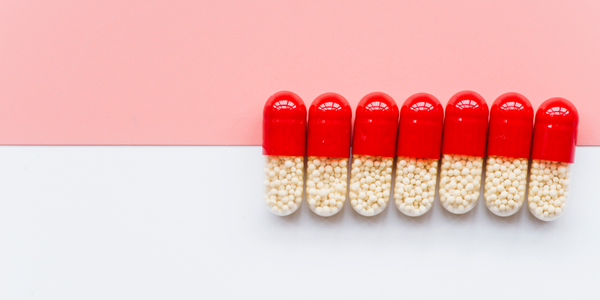An important determinant of good health and well-being is a sound immune system. Merriam-Webster defines the term "immunity" as the quality or state of being immune. When your body can resist and fight off infectious pathogens and prevent you from falling sick or help you recover faster, you know you have good immunity. The need for a strong immune system is perhaps more important than ever now, after the pandemic.
In this article, we shall explore the concept of immunity and its different types, which will further help you understand why it is crucial to lead a healthy life.
What is Immunity?
We are all surrounded by numerous microorganisms, such as viruses, bacteria, fungi, and protozoa. We are exposed to them through the food we eat, the air we breathe, or the water we drink. While most of these microorganisms are harmless, some cause diseases. These infection- and disease-causing microbes are known as pathogens. Every living organism has a mechanism designed to defend itself against these unwanted pathogens. This mechanism either destroys these harmful microbes after they enter the body or prevents them from entering the body in the first place. This defence mechanism is known as immunity.
Among human beings, a structure known as the immune system (made up of a complex network of cells, tissues, chemicals, proteins, and organs) refers to immunity. The primary functions of the immune system are as follows:
1. Protect the body:
The immune system defends the body against harmful and infectious pathogens, viruses, and bacteria, thereby safeguarding the body's integrity. It also designs an immune response that deactivates or eliminates germs.
2. Identify the threat:
Your immune system is constantly on guard and attentive. It does the job of identifying the threat as soon as possible. Sometimes, the immune system identifies certain antibodies as threats and starts eliminating them; this is what we refer to as an auto-immune disease.
3. Discard the unwanted cells:
The immune system helps to clear up and discard the body’s own infected or dead cells and the resultant malfunctioning.
Parts of the Immune System
1. White Blood Cells:
White blood cells are essential components of your immune system. They are produced in your bone marrow and are a component of your lymphatic system. White blood cells travel throughout your body, searching for foreign invaders (microbes) such as bacteria, viruses, parasites, and fungi. They launch an immune attack when they identify something as a threat. White blood cells comprise lymphocytes (B-cells, T-cells, and natural killer cells), granulocytes, and monocytes.
2. Antibodies:
Antibodies aid the body in combating microorganisms and the toxins (poisons) they create. They accomplish this by recognizing antigens on the surface of the organism or in the chemicals they make, which identify the microbe or toxin as alien. These antigens are then marked for destruction by the antibodies. This onslaught involves numerous cells, proteins, and molecules.
3. Lymphatic System:
The lymphatic system (composed of lymph nodes, lymph vessels, and white blood cells) is a delicate network of tubes that run throughout the body. The lymphatic system's primary functions are to control fluid levels in the body, respond to bacteria, deal with cancer cells and cell products that would otherwise result in sickness or diseases, and absorb part of the fats in our diet from the intestine.
4. Spleen:
The spleen is a blood-filtering organ that eliminates germs while also destroying old or damaged red blood cells. It also produces immune system components that combat sickness (including antibodies and lymphocytes).
5. Bone Marrow:
The spongy tissue located inside your bones is called bone marrow. It generates the red blood cells required by our body to transport oxygen, the white blood cells required to combat infection, and the platelets required to help our blood clot.
6. Thymus:
The thymus filters and monitors the contents of your blood. It generates T-lymphocytes, which are white blood cells.
7. Tonsils:
Tonsils are located perfectly—right after an opening—to kill the germs entering your body. They also contain ample white blood cells to fight off germs.
Mucus membrane: Your gut contains around 70% of your immune cells. Mucus membrane lines all the organs in your GI tract to keep them safe. Your immune cells in the GI tract are situated under the mucus membrane, thus eliminating the foreign particles trapped by the mucus membrane.
Types of Immunity
The body’s immunity can be classified into different types depending on how it has developed. Let’s look at them in detail below.
1. Innate Immunity
This form of immunity is inherent in all of us. To put it simply, it's the immunity that we are born with, and there’s a substantial genetic influence on the same. Its function is, therefore, quite generic, which is that it attacks any germs or pathogens that threaten the body. This innate immune system component immediately triggers an immune response once the pathogen enters the body. Furthermore, it informs the acquired or adaptive immune system about the pathogen’s entry so that it can be better prepared should the pathogen invade the body again in the future.
Innate immunity has two essential components, which are as follows:
- The external component: This is an essential part as it is the first line of defense. It acts as a protective barrier against harmful pathogens, disallowing them from entering the body. This includes organs like the skin, stomach acid, and mucous membranes.
- The internal component: Once the pathogens enter the body, this component of your innate immunity gets activated. This component includes mechanisms like an inflammatory response, fever, and phagocytosis, which is a process by which natural killer cells, or macrophages, of our body can circle the germs and kill them one by one.
2. Adaptive or Acquired Immunity
If your innate immunity fails to evade the pathogens, that’s when the adaptive or acquired immunity gets activated. The name of this immunity is relatively self-explanatory. Adaptive immunity develops over a period of time as the body is exposed to more and more pathogens. This form of immunity takes time to develop and targets only specific pathogens. Suppose a particular pathogen manages to get past the innate immunity and enter the body. Here’s when the adaptive or acquired immunity starts working, whereby the body then remembers the pathogen through immunological memory. This way, it provides long-term immunity.
This form of immunity can further be differentiated into the following types:
Active immunity:
As your body gets exposed to different pathogens, it automatically develops immunity cells like B-cells and T-cells. The role of these cells is to clear and discard live germs by creating antibodies, also known as humoral immunity or cell-mediated immunity. Simultaneously, they also trigger the immunological memory versions of these cells that help the body respond to future infections caused by a similar pathogen. Active acquired immunity can be further classified into two different types: natural and artificial.
- Natural active acquired immunity: This form of active acquired immunity is activated when the body is naturally exposed to pathogens due to infection. Through exposure, the body automatically produces antibodies that fight off the pathogen. At the same time, the memory cells created help the body have a more prompt and efficient immune response the next time the same type of pathogen attacks the body.
- Artificial active acquired immunity: Anything that’s not naturally created, is referred to as artificial. When the infection occurs in a controlled manner, such as in the case of vaccination, the resultant acquired immunity is artificial in nature. During vaccination or immunization, an inactivated or dead germ, antigens, or toxins are injected into the body. While this does not trigger a severe infection or disease, it aids the body in developing the right kind of antibodies to fight the pathogen. In this way, memory cells are also created to help the body fight the pathogens if there is ever a re-infection. Examples of this are vaccinations against COVID-19, tetanus, whooping cough, diphtheria, etc.
Passive Immunity:
This is another form of acquired immunity. Passively acquired immunity gets activated when the body is provided with readymade antibodies to fight a particular infection. This form of immunity is provided to high-risk patients or those with immunodeficiencies. Those with immunodeficiencies are not able to create antibodies on their own. An example of this is when a patient is given intravenous immune proteins prepared out of sterile blood plasma containing antibodies for a particular disease. This will automatically provide quick but temporary protection against the disease. However, given that there is no exposure to the germ, the body cannot develop immunological memory, and that’s why it won’t be able to defend the body against the occurrence of future infections. As a result, the protection provided by this is temporary.
Like active immunity, even passive immunity is further categorized as natural and artificial immunity.
- Natural passive acquired immunity: This form of immunity can be best explained with an example of a newborn baby. A newborn baby’s immunity is dependent on the mother’s immunity for the initial years. Before the baby is born, the fetus gets certain specific antibodies from the mother through the placenta. These antibodies protect the baby until its immune system is fully developed. Once it is born, it receives the same immunity through the mother’s milk. This form of passive immunity protects the baby in the initial stages of infancy.
- Artificial passive acquired immunity: This form of immunity is developed in a controlled environment by introducing ready-made antibodies, particularly to a disease in question. This is given to an immunologically deficient person to help him fight the infection. For instance, the blood plasma of a COVID survivor is intravenously given to another person with a weakened immune system to fight the disease.
3. Herd Immunity
This is an indirect form of developing immunity. For this type of immunity to get activated, many people need to develop antibodies against a particular infection through vaccination or a prior illness. Once that happens, the remaining people automatically get protected. This takes a lot of time, as the infectious/contagious disease chain needs to break, stopping the virus from spreading further. Having said that, it’s always best to stay protected from potent pathogens by getting vaccinated.
Healthy Living for Better Immunity
Keeping a healthy lifestyle is essential for maintaining a robust immune system and battling infections and disorders. Here are some critical immunity-boosting habits:
- Consume a well-balanced diet that includes plenty of fruits, vegetables, healthy grains, and lean proteins.
- Invest in immunity-boosting supplements. Eating healthy is not enough to bridge the nutritional gap. Supplements, however, provide your body with the missing vitamins and minerals needed to fight off pathogens.
- Drink plenty of water to keep your body hydrated.
- Physical activity can be great for boosting immunity by increasing the circulation of antibodies and white blood cells in your body.
- Sleep is essential for immunological function; aim for 7-9 hours of sleep every night.
- Because chronic stress can impair your immune system, try relaxing practices like yoga, meditation, or deep breathing.
- Avoid smoking and heavy alcohol intake, as both can deplete your immune system and raise your risk of disease.
- Hand washing with soap and water on a regular basis can help reduce the spread of germs and diseases.
Keep in mind that everyone's immune system is unique, and what works for one person may not work for another. For personalized advice, speak with a doctor or a healthcare professional.
Wrapping Up
Your immune system is perhaps the most essential system in your body that keeps it healthy and running. To fight any infection and protect yourself from falling sick, you need to have a robust immune system. That is when natural immunity-boosting foods and supplements come into the picture. Ensure that you have a healthy diet comprising essential nutrients like vitamins C, D, and E, zinc, selenium, iron, calcium, magnesium, folate, and antioxidants. If your food doesn’t provide sufficient nutrients, don’t avoid including dietary supplements in your daily routine.
References:
- https://www.cdc.gov/vaccines/vac-gen/immunity-types.html
- Fox JP, Elveback L, Scott W, et al. Herd immunity: basic concept and relevance to public health immunization practices. Am J Epidemiol 1971; 94:179–89, (https://pubmed.ncbi.nlm.nih.gov/5093648/)
- Plotkin S. History of vaccination. Proc Natl Acad Sci U S A. 2014;111(34):12283-12287. doi:10.1073/pnas.1400472111, (https://www.ncbi.nlm.nih.gov/pmc/articles/PMC4151719/)
- Warrington, R., Watson, W., Kim, H.L. et al. An introduction to immunology and immunopathology. All Asth Clin Immun 7, S1 (2011). https://doi.org/10.1186/1710-1492-7-S1-S1, (https://aacijournal.biomedcentral.com/articles/10.1186/1710-1492-7-S1-S1#citeas)
- Chaplin DD. Overview of the immune response. J Allergy Clin Immunol. 2010;125(2 Suppl 2):S3-S23. doi:10.1016/j.jaci.2009.12.980, (https://www.ncbi.nlm.nih.gov/pmc/articles/PMC2923430/)



























 DOWNLOAD NOW
DOWNLOAD NOW
